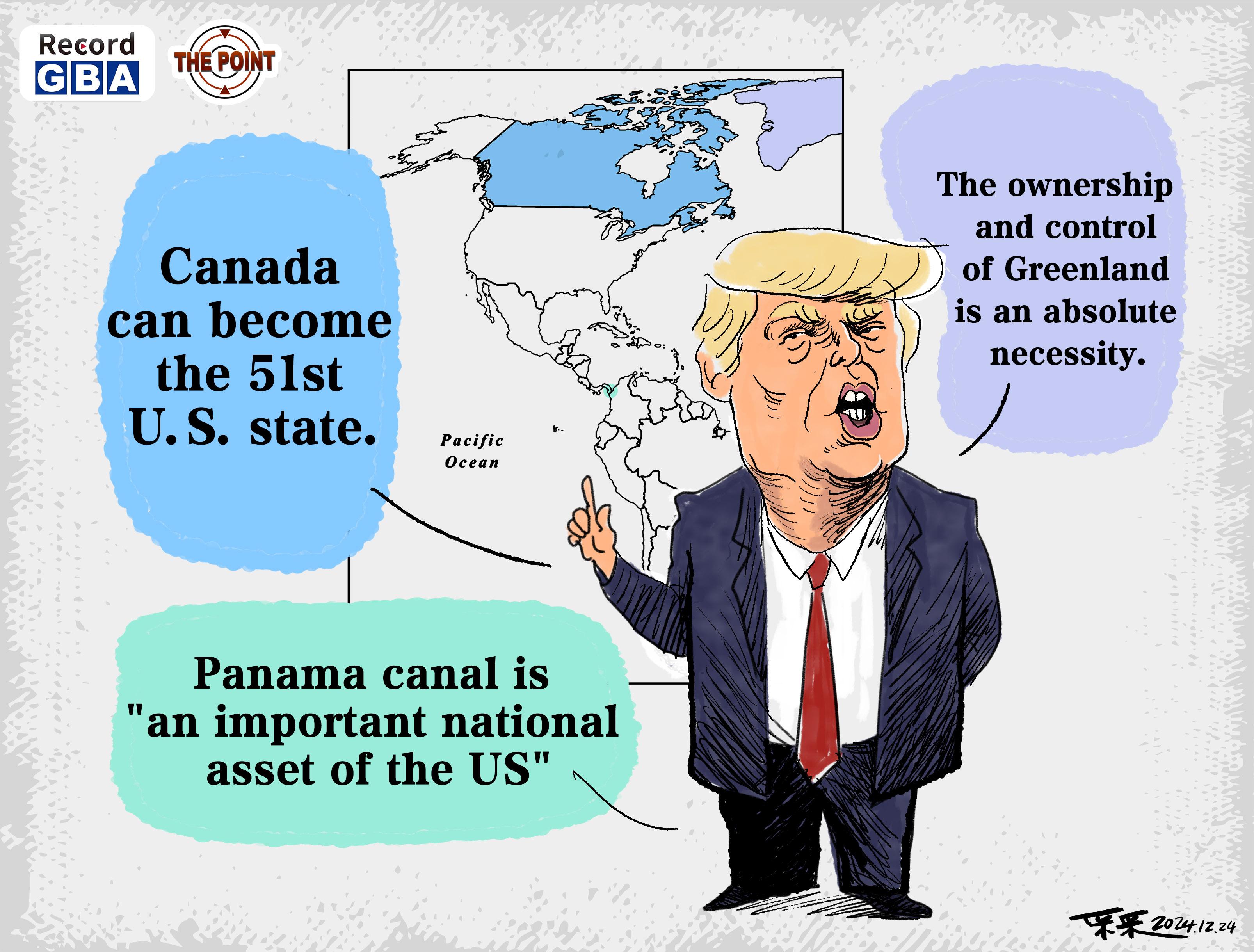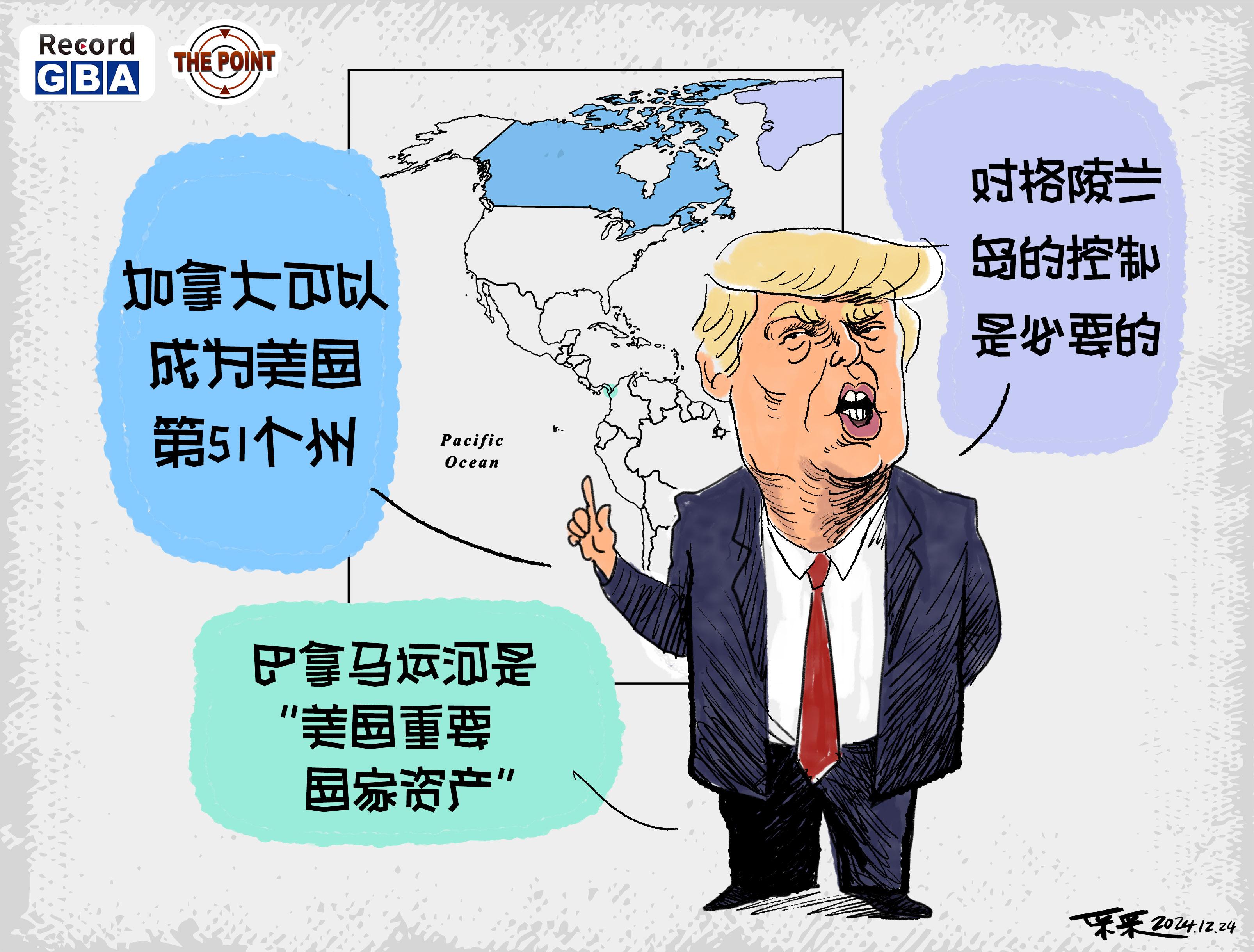

Recently, it appears that Donald Trump has become enamored with the idea of expanding American territory.
On December 10th, he said on social media that it would be a delightful occurrence if Canada became the "51st state" of the United States, later referring to Canadian Prime Minister Justin Trudeau as "Governor Trudeau."
Trudeau himself could only respond by saying that "Trump was joking."
On the 22nd, during a speech at a rally in Phoenix, Arizona, Trump suddenly brought up the Panama Canal. He claimed that the United States had paid too much for the construction of the canal and later "foolishly" handed it over to Panama. He accused the canal's management of charging high fees to American vessels, deceiving the United States, and suggested that the canal might fall into the wrong hands.
As a result, he threatened that if Panama does not take heed, the United States might "take back" the Panama Canal once he takes office.
The Panama Canal, a vital link between the Atlantic and Pacific Oceans, was originally constructed under the leadership of the United States and opened in 1914, reducing the maritime transport distance from the east to the west coast of the United States by approximately 15,000 kilometers. In 1999, the U.S. government, in accordance with an agreement signed in 1977, handed over the management of the canal to Panama. The Panamanian government continued to expand and upgrade the canal's facilities. Currently, the cargo passing through the Panama Canal accounts for about 2.5% of global maritime transport, and the canal's revenue is an important source of income for the Panamanian government.
In response to Trump's claim about reclaiming the canal, Panamanian President Laurentino Cortizo immediately retorted that the canal's fees are set transparently and publicly by a team of experts based on market conditions, and that the canal is entirely under Panama's control, with "every square meter" of the canal area being Panamanian territory.
However, Trump responded on social media with "We'll see!" accompanied by an image of the U.S. flag flying over the Panama Canal, captioned "Welcome back to the USA."
A few hours later, Trump announced his nominee for ambassador to Denmark on social media, stating that, for strategic and American interests, the United States "might need" to possess Greenland.
Greenland, the world's largest island, covers an area of 2.16 million square kilometers, mostly within the Arctic Circle, covered in ice and snow, and has a sparse population of only about 50,000 to 60,000 people. The island is an autonomous territory of Denmark.
During his first term, Trump had proposed purchasing Greenland, which was rebuffed by the then Danish Prime Minister, who dismissed the idea as nonsense, leading Trump to cancel his visit to Denmark.
Naturally, this reiteration of old remarks has been met with refutation from Denmark.
In just two weeks, from Greenland to Canada, and then to the Panama Canal, Trump's remarks on these regions have continuously stirred up public opinion and sparked verbal disputes.
The United States has rarely had territorial claims on other countries after World War II, let alone an elected president so openly and blatantly stating such desires. While Trump's statements or ideas are essentially impossible from a practical standpoint, they may sound absurd at first glance, but they are noteworthy because they reflect Trump's diplomatic style and could have actual implications.
First, there is a lack of "respect." Canada is an important neighbor to the United States, and as an elected president, Trump's public reference to Trudeau as a "governor" on social media, even in jest, is extremely disrespectful and lacks basic courtesy.
Second, there is a strong element of "bullying." This is particularly evident in his attitude towards Panama. To openly state the "reclamation" of a small country's territory and use language like "we'll see" is heavily laden with bullying.
Third, these seemingly absurd remarks by Trump should not be taken lightly.
Trump's three "territorial" statements are all intertwined with concepts of tariffs, economic interests, American interests, and American security, reflecting to some extent the views of some right-wing conservatives in the United States.
Although these statements are outlandish, when spoken by the incoming president, they could become topics of discussion and even diplomatic issues under certain conditions.
Moreover, Trump's diplomatic style and tactics may also be applied to other regions and fields in the future.
Source: Lingnan on the Cloud
特朗普“胃口”大:巴拿马运河和格陵兰岛他都想要

特朗普最近似乎对扩张美国领土着了迷。
12月10日,他在社交媒体上说,如果加拿大成为美国“第51个州”,那将是令人非常高兴的事。后来又称加拿大总理特鲁多为“特鲁多州长”。
特鲁多本人只能以“特朗普在开玩笑”回应。
22日,特朗普在亚利桑那州凤凰城一个集会上讲话时,突然提起巴拿马运河。称美国当年为开凿巴拿马运河付出太多,后来却“愚蠢地”把运河给了巴拿马,现在运河管理方对美国船只收费很高,欺骗美国,而且运河可能落入“错误的人”手中。
因此他威胁如果巴拿马不注意点,他上台后美国可能“收回”巴拿马运河。
巴拿马运河是连接大西洋和太平洋的重要通道,当年由美国主导修建,1914年开通,美国东岸到西岸的海洋运输缩短1.5万公里左右。1999年,美国政府根据美巴1977年签署的协议,将运河交给巴拿马管理。巴拿马政府接手继续扩展运河,提升设备。目前经由巴拿马运河的运量占全球海运的约2.5%,运河收入也是巴拿马政府的重要收入来源。
因此特朗普说要收回运河,巴拿马总统穆利诺立即反驳,称运河收费是由专家团根据市场情况,透明公开设定的,运河完全掌握在巴拿马手里,运河区“每1平方米”的土地都是巴拿马的领土。
但特朗普还是在社交媒体上回应“那我们走着瞧!”并且贴了一张美国国旗飘扬在巴拿马运河上空的图片,配文为“欢迎回到美国”。
几个小时之后,特朗普在社交媒体上宣布提名其驻丹麦大使人选时又说,出于战略和美国利益考虑,如果美国“有必要”拥有格陵兰岛。
格陵兰岛是世界上最大岛屿,面积216万平方公里,大部分位于北极圈内,被冰雪覆盖,人口稀少,只有五六万人。该岛属于丹麦的一个自治区。
特朗普在其第一任期内曾提过要购买格陵兰岛,被当时的丹麦总理反驳,称其想法为胡说,为此特朗普还取消了对丹麦的访问。
这次旧话重提,自然又遭到丹麦方面的反驳。
短短两个星期,从格陵兰岛到加拿大,再到巴拿马运河,特朗普对这些地区的言论不断掀起舆论风波,也引发口水战。
美国二战后几乎没有对其他国家有领土诉求,更不用说一个当选总统如此公开露骨地说出来。虽然特朗普的这些说法或者说想法,从实际操作角度基本上都是不可能的,所以乍一听有些荒诞不经,但细想其实还是值得注意,因为它反映出特朗普的外交风格,也可能会带来实际的影响。
一,缺乏“尊重”。加拿大是美国重要邻国,作为当选总统,特朗普在社交媒体上公开称特鲁多为“州长”,即使是开玩笑,也是非常失礼、缺乏起码尊重的。
二,有强烈的“霸凌”色彩。对巴拿马的态度特别明显。针对一个小国,公然说要“收回”其领土,并用“我们走着瞧”之类的语言,霸凌气味非常浓。
三,对于特朗普这些貌似荒诞的言论,也不能大意。
特朗普这三个有关“领土”的说法,都是和关税、经济利益、美国利益、美国安全等概念交织在一起,他多多少少反映了美国一些右翼保守人士的观点。
这些说法虽然离谱,但是特朗普作为即将上任的总统,由他说出这样的话,这些问题就可能成为一个话题,形成讨论,在一定条件上甚至成为外交问题。
而且,特朗普这种外交风格和操作手法,今后可能也会用于其他地区和其他领域。
文丨羊城晚报国际评论员 钱克锦 记者 赵鹏
漫画丨蔡红
译丨赵凡
英文审校丨林佳岱
-
Poster | The Maritime short films offer a fresh viewing experience, with enthusiastic responses from Paris citizens
2024-12-24 22:05:17 -
ThePoint丨Arming Taiwan is just like playing with fire
2024-12-24 23:15:14 -
The first metro circular line in the GBA set to open
2024-12-23 22:49:53 -
The Maritime short films offer a fresh viewing experience, with enthusiastic responses from Paris citizens|Maritime · Paris
2024-12-23 22:48:06






